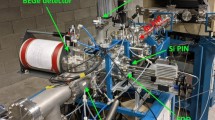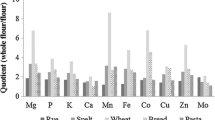Abstract
Elemental concentrations in breakfast cereals consumed in Mexico were measured using Particle induced X-ray emission with 1.7 MeV protons and X-ray fluorescence with a Rh X-ray tube operating at 35 kV. The specimens, obtained from packages purchased in markets, were freeze dried, ground and pelletized. Standardization was done with tomato, spinach, peach, and orchid leaves NIST standard reference materials, and analytical accuracy verified with NIST 3233 standard reference material (fortified cereal). The concentrations of nine elements did not agree with values quoted in the packages. Therefore, there may be inaccurate official estimations of Mexican population nutrient intakes.







Similar content being viewed by others
References
Zapata L (2010) Cereals: a comparative study of cereals and cereal bars. In: Organización de consumidores y usuarios de Chile. SERNAC, Santiago (in Spanish)
Soreng RJ, Peterson PM, Romschenko K, Davidse G, Zuloaga FO, Judziewicz EJ, Filgueiras TS, Davis JI, Morrone O (2015) A worldwide phylogenetic classification of the Poaceae (Gramineae). J Syst Evol 53:117–137
Dávila-Aranda PD, Sánchez-Ken JG, Cabrera-Martínez LI (1993) Gramineae: general characteristics and importance. Bol Inst Bot (Guadalajara) 1:397–421 (in Spanish)
Kulp K, Ponte JG (2000) Handbook of cereal science and technology, 2nd edn. Marcel Dekker, New York
UNFPA (2018) World population dashboard. https://www.unfpa.org/data/world-population-dashboard. Accessed 28 June 2018. United Nations Population Fund, New York
FAO (2018) Food and agriculture data. http://www.fao.org/faostat/en/#data. Accessed 5 Mar. 2018. Food and Agriculture Organization of the United Nations, Rome
UNO (2017) 2016 International trade statistics yearbook, vol II. Department of Economic and Social Affairs, United Nations Organization, New York
Olivares M, Pizarro F, de Pablo S, Ayala M, Uauy R (2004) Iron, zinc, and copper: contents in common Chilean foods and daily intakes in Santiago, Chile. Nutrition 20:205–212
Pineda-Vargas SS, O’Neil CE, Keast DR, Cho SS, Nicklas TA (2016) Eating ready-to-eat cereal for breakfast is positively associated with daily nutrient intake, but not weight, in Mexican–American children and adolescents: national health and nutrition examination survey 1999–2002. Nutr Today 51:206–215
SSA (2008) Mexican Official Standard NOM-247-SSA1-2008, Products and services. In: Cereals and their products. Secretaría de Salud, Mexico City (in Spanish)
INSP (2012) National health and nutrition survey. Instituto Nacional de Salud Pública, Cuernavaca (in Spanish)
Sánchez-Pimienta TG, López-Olmedo N, Rodríguez-Ramírez S, García-Guerra A, Rivera JA, Carriquiry AL, Villalpando S (2016) High prevalence of inadequate calcium and Iron intakes by Mexican population groups as assessed by 24-hour recalls–4. J Nutr 146:1874–1880
INSP (2012) Databases of food nutritional values. In: A compilation of National Public Health Institute. Instituto Nacional de Salud Pública, Cuernavaca (in Spanish)
Booth CK, Reilly C, Farmakalidis E (1996) Mineral composition of Australian ready-to-eat breakfast cereals. J Food Compos Anal 9:135–147
Tinggi U, Reilly C, Patterson C (1997) Determination of manganese and chromium in foods by atomic absorption spectrometry after wet digestion. Food Chem 60:123–128
Mateos CJ, Aguilar MV, Martínez-Para MC (2003) Determination of the chromium content in commercial breakfast cereals in Spain. J Agric Food Chem 51:401–405
Canett-Romero D (2000). Nutritional quality of breakfast cereals consumed in the city of Hermosillo. M.Sc. Thesis, Universidad de Sonora, Hermosillo (in Spanish)
Latimer GW (ed) (2012) Official methods of analysis of AOAC international, 19th edn. AOAC International, Gaithersburg
De la Guardia M, Garrigues S (2015) X-ray. In: De la Guardia M, Garrigues S (eds) Handbook of trace elements in food. Wiley, Chichester
Romero-Dávila E, Miranda J (2004) Trace element determination in tomato puree using PIXE and Rutherford backscattering. J Radioanal Nucl Chem 262:355–362
Romero-Dávila E, Miranda J, Pineda JC (2015) X-ray fluorescence analysis of Mexican varieties of dried chili peppers II: commercial and home-grown specimens. In: AIP conference proceedings 1671: paper #020006
Hernández MC, Romero D, Torres H, Miranda J, Hernández-López AE (2017) X-ray fluorescence analysis of ground coffee. J Nucl Phys Mater Sci Radiat Appl 5:25–34
Andrade E (1991) Ion beam analysis at the University of Mexico. Nucl Instrum Methods Phys Res, Sect B 56:802–805
Espinosa AA, Reyes-Herrera J, Miranda J, Mercado F, Veytia MA, Cuautle M, Cruz JI (2012) Development of an X-ray fluorescence spectrometer for environmental science applications. Instrum Sci Technol 40:603–617
IAEA (1995) Manual for QXAS. International Atomic Energy Agency, Vienna
Reyes-Herrera J, Miranda J, De Lucio OG (2015) Simultaneous PIXE and XRF elemental analysis of atmospheric aerosols. Microchem J 120:40–44
Rousseau RM (2001) Detection limit and estimate of uncertainty of analytical XRF results. Rigaku J 18:33–47
WHO (2012) Guideline: sodium intake for adults and children. World Health Organization, Geneva
WHO (2012) Guideline: potassium intake for adults and children. World Health Organization, Geneva
Mataix-Verdú J (2002) Nutrición y alimentación humana. Ergon, Madrid (in Spanish)
Friedman BJ, Freeland-Graves JH, Bales CW, Behmardi F, Shorey-Kutschke RL, Willis RA, Crosby RJB, Trickett PC, Houston SD (1987) Manganese balance and clinical observations in young men fed a manganese-deficient diet. J Nutr 117:133–143
Aras NK, Ataman O (2006) Trace element analysis of food and diet. RSC Publishing, Cambridge
WHO (1996) Trace elements in human nutrition and health. World Health Organization, Geneva
Spivey N (2015) Analysis of micronutrients in fortified breakfast cereal by flame atomic absorption using microwave digestion and FAST flame sample automation. In: Perkin Elmer Application Note. PerkinElmer, Inc., Waltham
Acknowledgements
The authors thank the technical support of L. Martínez-Arellano (bibliographic search), G. Rayo and C. Valencia (Van de Graaff accelerator maintenance and operation). Work supported in part by CONACyT (Grant 253051) and DGAPA-UNAM (Grant IN-102615).
Author information
Authors and Affiliations
Corresponding author
Rights and permissions
About this article
Cite this article
Romero-Dávila, E., Miranda, J., de Lucio, O.G. et al. PIXE and XRF elemental analysis of breakfast cereals consumed in Mexico. J Radioanal Nucl Chem 318, 887–895 (2018). https://doi.org/10.1007/s10967-018-6052-5
Received:
Published:
Issue Date:
DOI: https://doi.org/10.1007/s10967-018-6052-5




